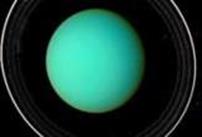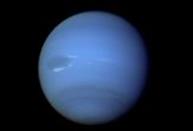Топик: Solar System
Jupiter
 The fifth planet from the sun is a huge ball of gas so massive it could hold all the other planets put together. What we can see of the planet are bands of the highest clouds in a thick atmosphere of hydrogen and helium. Traces of other gases produce the bright bands of color.
The fifth planet from the sun is a huge ball of gas so massive it could hold all the other planets put together. What we can see of the planet are bands of the highest clouds in a thick atmosphere of hydrogen and helium. Traces of other gases produce the bright bands of color.
The Red Spot
Jupiter's most familiar feature is swirling mass of clouds that are higher and cooler than surrounding ones. Called the Great Red Spot, it has been likened to a great hurricane and is caused by tremendous winds that develop above the rapidly spinning planet. Winds blow counterclockwise around this disturbance at about 250 miles per hour. Hurricanes on Earth rarely generate winds over 180 miles an hour.
The Red Spot is twice the size of Earth and has been raging for at least 300 years. It is one of several storms on Jupiter.
Inside Jupiter
At Jupiter's center is a core of rock many times the mass of Earth. But the bulk of the planet is a thick gaseous murk that appears smeared through a telescope because the planet moves so rapidly beneath. Jupiter's rapid rotation causes it to bulge, making the diameter 7 percent greater at the equator than at the poles.
Around Jupiter
Jupiter has thin, barely perceptible rings and at least 16 satellites. The four largest-- Io, Europa, Ganymede and Callisto -- are called the Galilean moons. They orbit in the same plane and are all visible in a telescope.
JUPITER: RULER OF THE ROMAN GODS, ALSO JOVE
Historical notes
Jupiter was believed by Mesopotamians to be a wandering star placed in the heavens by a god to watch over the night sky. In 1610, Galileo Galilei used a 20x telescope to observe three "stars"  around Jupiter. Over several nights he observed these "stars," but each night they were in different positions, leading to his conclusion that they were bodies orbiting the giant planet.
around Jupiter. Over several nights he observed these "stars," but each night they were in different positions, leading to his conclusion that they were bodies orbiting the giant planet.
In 1994, astronomers around the world watched as the fragments of comet Shoemaker-Levy 9 struck Jupiter -- an event that had been forecast. This image shows a bright cloud more than 8,600 miles in diameter caused by the impact.
Final fact
You could stuff 1,300 Earths into Jupiter
Saturn
 Much like its neighbor Jupiter, the sixth planet from the sun has a rocky core and a gaseous surface. But Saturn is chiefly known for its intricate series of rings that encircle it. The mile-thick rings are made of countless orbiting ice particles, from less than an inch to several feet in size.
Much like its neighbor Jupiter, the sixth planet from the sun has a rocky core and a gaseous surface. But Saturn is chiefly known for its intricate series of rings that encircle it. The mile-thick rings are made of countless orbiting ice particles, from less than an inch to several feet in size.
Up close, it's clear that Saturn has more rings than we can count. But though you can't see all of them from Earth, you can spot three of them with a good telescope,.
The two outermost rings are separated by a dark band called the Cassini Division, named for the astronomer who discovered it in 1675. The Cassini division isn't empty, but it has less material in it. The middle ring is the brightest, and just inside it is a fuzzy one that can be difficult to spot.
Saturn has 18 known satellites, made mostly of ice and rock. The largest, Titan, orbits Saturn every 16 days and is visible through a good-sized amateur telescope. Titan, which is larger than the planet Mercury, has a thick atmosphere that obscures its surface. Though researchers aren't sure how many moons Saturn has, the total is likely at least 20, and may be much higher.
Historical notes
When Galileo Galilei first studied Saturn in the early 1600s, he thought it was an object with three parts. Not knowing he was seeing a planet with rings, the stumped astronomer entered a small drawing -- a symbol with one large circle and two smaller ones -- in his notebook, as a noun in a sentence describing his discovery. Debate raged for more than 40 years about these "ears," until Christiaan Huygens proposed that they were rings. Giovanni Domenico Cassini later discovered a gap between the rings, which gained his name, and he also proposed that the rings were not solid objects, but rather made of small particles.
Uranus
 The seventh planet from the sun is much like its gaseous neighbors, with a cloudy surface, rapid winds, and a small rocky core.
The seventh planet from the sun is much like its gaseous neighbors, with a cloudy surface, rapid winds, and a small rocky core.
URANUS: PERSONIFICATION OF HEAVEN IN ANCIENT MYTH
Perhaps because of a collision with a large object long ago, Uranus orbits at an extreme tilt of 98 degrees -- sort of on its side. This causes one pole to point toward the sun for decades, giving the planet strange seasons.
Uranus has numerous satellites and a faint set of rings. If all the possible satellites being studied are confirmed, Uranus would have 16 regular and five irregular moons, making it the most populated planetary satellite system known. Saturn is known to have 18 satellites (there may be more, but they have not been well-documented).
Historical notes
Uranus was thought to be a star until William Herschel discovered in 1781 that it orbited the Sun.
Neptune
 The eighth planet from the Sun -- well, some of the time it's eighth, but more on that later -- has a rocky core surrounded by ice, hydrogen, helium and methane.Like the other gas planets, Neptune has rapidly swirling winds, but it is thought to contain a deep ocean of water. Its quick rotation fuels fierce winds and myriad storm systems. The planet has a faint set of rings and 8 known moons.
The eighth planet from the Sun -- well, some of the time it's eighth, but more on that later -- has a rocky core surrounded by ice, hydrogen, helium and methane.Like the other gas planets, Neptune has rapidly swirling winds, but it is thought to contain a deep ocean of water. Its quick rotation fuels fierce winds and myriad storm systems. The planet has a faint set of rings and 8 known moons.